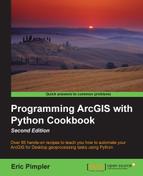The query operation in the ArcGIS REST API performs a query against a map service and returns a feature set. The feature set includes values for fields requested by the user and can also return geometry, if requested.
In this recipe, you will build on the first recipe, in which you generated a URL using the ArcGIS Services page dialog box to generate results. In this recipe, you will use the ArcGIS Server Services page dialog box to generate a URL request that queried a map service layer and returned results. You may recall that the URL was http://sampleserver1.arcgisonline.com/ArcGIS/rest/services/Demographics/ESRI_Census_USA/MapServer/1/query?text=&geometry=&geometryType=esriGeometryPolygon&inSR=&spatialRel=esriSpatialRelIntersects&relationParam=&objectIds=&where=STATE_FIPS+%3D+%2748%27+and+CNTY_FIPS+%3D+%27021%27&time=&returnCountOnly=false&returnIdsOnly=false&returnGeometry=false&maxAllowableOffset=&outSR=&outFields=POP2000%2CPOP2007%2CBLKGRP&f=pjson.
Now, let's learn how to submit this request using Python.
- In IDLE or another Python development environment, create a new Python script called
QueryMapService.pyand save it to theC:ArcpyBookCh12folder. - In your browser, navigate to: http://resources.arcgis.com/en/help/arcgis-rest-api/index.html#//02r3000000p1000000. This is the REST API page for the
queryoperation against a layer in a map service. As you scroll down thehelppage, you should see the same parameters as were generated using the dialog box, such asgeometry,geometryType,inSR,spatialRel,where, and others. - In your script, import the
requestsandjsonmodules:import requests import json
- Create the following
agisurlvariable. This will serve as the base URL that references thequeryoperation on thecensus block grouplayer (identified by an identifier of1in the URL) in theESRI_Census_USAmap service:import requests import json agisurl = "http://sampleserver1.arcgisonline.com/ArcGIS/rest/services/Demographics/ESRI_Census_USA/MapServer/1/query" - Now, create a Python dictionary object, as shown in the following code. We're going to leave out some of the parameters that were not defined or used in the dialog box. We're just creating an attribute query in this instance so that all the geometry parameters can be removed:
import requests import json agisurl = "http://sampleserver1.arcgisonline.com/ArcGIS/rest/services/Demographics/ESRI_Census_USA/MapServer/1/query" payload = { 'where':'STATE_FIPS = '48' and CNTY_FIPS = '021'','returnCountOnly':'false', 'returnIdsOnly': 'false', 'returnGeometry':'false', 'outFields':'POP2000,POP2007,BLKGRP', 'f': 'pjson'}
- The
requests.get()method can accept a Python dictionary object as the second parameter. This dictionary defines the set of key/value pairs that help define the query string. Add therequests.get()method:import requests import json agisurl = "http://sampleserver1.arcgisonline.com/ArcGIS/rest/services/Demographics/ESRI_Census_USA/MapServer/1/query" payload = { 'where':'STATE_FIPS = '48' and CNTY_FIPS = '021'','returnCountOnly':'false', 'returnIdsOnly': 'false', 'returnGeometry':'false', 'outFields':'POP2000,POP2007,BLKGRP', 'f': 'pjson'} r = requests.get(agisurl, params=payload) - Include a
printstatement in order to print the response that is returned.import requests, json agisurl = "http://sampleserver1.arcgisonline.com/ArcGIS/rest/services/Demographics/ESRI_Census_USA/MapServer/1/query" payload = { 'where':'STATE_FIPS = '48' and CNTY_FIPS = '021'','returnCountOnly':'false', 'returnIdsOnly': 'false', 'returnGeometry':'false', 'outFields':'POP2000,POP2007,BLKGRP', 'f': 'pjson'} r = requests.get(agisurl, params=payload) print(r.text) - Save the script and run it to see this output:

- Now, convert this JSON object to a Python dictionary. Also, comment out the
printstatement that you added in the last step:r = requests.get(agisurl, params=payload) #print(r.text) decoded = json.loads(r.text)
- The Python dictionary object returned by the
json.loads()method will contain the contents of the JSON object. You can then pull the individual data elements out of the dictionary. In this case, we want to pull out the attributes of each of the feature returned(BLKGRP,POP2007, andPOP2000). We can do so by using the following code, which you'll need to add to your script:r = requests.get(agisurl, params=payload) #print(r.text) decoded = json.loads(r.text) for rslt in decoded['features']: print("Block Group: " + str(rslt['attributes']['BLKGRP'])) print("Population 2000: " + str(rslt['attributes']['POP2000'])) print("Population 2007: " + str(rslt['attributes']['POP2007']))
- You can check your work by examining the
C:ArcpyBookcodeCh12QueryMapService.pysolution file. - Save and execute your script to see these results:

The query operation in the ArcGIS REST API can be used to perform spatial and attribute queries against a layer in an ArcGIS Server map service. We used the requests.get() method to perform an attribute query against the census block groups layer. We included various parameters, including a where clause that will only return records where the ST_FIPS code is 48 and the CNTY_FIPS code is 021 (Bexar County, Texas). The response object was then converted to a Python dictionary and we included a for loop to iterate through each of the returned records and print out the block group name, and the population for the years 2000 and 2007.
